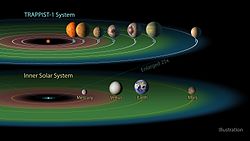TRAPPIST-1

TRAPPIST-1 (or 2MASS J23062928-0502285) is an ultracool red dwarf star located almost 40 light years away from the Sun in the constellation of Aquarius. The red dwarf is known for having seven Earth-sized rocky planets around it.[1] These planets were discovered between 2016 and 2017, and are likely rocky and some may even have liquid water on them.[2] Four of these planets (d, e, f, and g) are in the habitable zone, so they are most likely to have liquid water. Three other planets here (b, c, and h) are not in the habitable zone, and are likely not habitable.
Planets
In August of 2017, the Hubble Space Telescope possibly found traces of possible water in the atmospheres of some of the TRAPPIST-1 planets.[3][4]
- Trappist 1-b - The closest planet to Trappist 1 and likely akin to Venus. It's extremely hot (over 1400°K/ 1224°C at the surface) due to the planet only being 1.7 million km from its star. The planet has a likely runaway greenhouse effect that immures almost all of the heat that hits it.
- Trappist 1-c - The next closest planet to Trappist 1 and also likely Venus like.
- Trappist 1-d - At the innermost edge of the system's habitable zone, Trappist 1-d could be livable or too hot like Venus, it is debatable.
- Trappist 1-e - Squarely in the habitable zone, this planet is likely to have a slightly higher land to ocean ratio than Earth.
- Trappist 1-f - This planet is probably a water world.
- Trappist 1-g - The furthest planet from Trappist 1 that is confirmed to be in the system's liveable zone and could be a water world with little dry land.
- Trappist 1-h - The furthest out and the smallest planet in the system. The gravity is similar to that of the Moon and it's likely to be covered in an ice shell.
TRAPPIST-1 Media
True-colour illustration of the Sun (left) next to TRAPPIST-1 (right). TRAPPIST-1 is darker, redder, and smaller than the Sun.
This diagram compares the orbits of the newly-discovered planets around the faint red star TRAPPIST-1 with the Galilean moons of Jupiter and the inner Solar System. All the planets found around TRAPPIST-1 orbit much closer to their star than Mercury is to the Sun, but as their star is far fainter, they are exposed to similar levels of irradiation as Venus, Earth and Mars in the Solar System.
Habitable zones of TRAPPIST-1 and the Solar System. The displayed planetary surfaces are speculative.
Infrared measurements by the NASA / ESA / Canadian Space Agency / James Webb Space Telescope of TRAPPIST-1 c indicate that it is likely not as Venus-like as once imagined.
Graph showing dips in brightness in TRAPPIST-1 star by the planet's transits or obstruction of starlight. Larger planets create deeper dips and further planets create longer dips.
References
- ↑ https://www.space.com/41714-water-rich-exoplanets-trappist-1-system.html | TRAPPIST-1 Worlds Are Rocky and Rich in Water, New Research Uncovers | September 05, 2018
- ↑ https://www.nasa.gov/feature/jpl/new-clues-to-trappist-1-planet-compositions-atmospheres | New Clues to TRAPPIST-1 Planet Compositions, Atmospheres | Feb. 5, 2018 | NASA
- ↑ https://www.spacetelescope.org/news/heic1713/ Archived 2019-01-25 at the Wayback Machine | Hubble delivers first hints of possible water content of TRAPPIST-1 planets | 31 August, 2017
- ↑ "First evidence of water found on TRAPPIST-1 planets". 4 September 2017.







